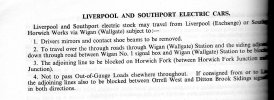I remember seeing a picture of the entrance to Liverpool Central Low Level shortly after nationalisation which said “To Wirral and Mersey Lines”.
Presumably the line to Rock Ferry was the “Mersey Line” with the lines to West Kirby and New Brighton being the “Wirral Line” in those days?
It could be slightly more complicated than that. Historical company differences persisted long after nationalisation, and it wasn't necessarily one branch from Hamilton Square versus the other.
The booking offices for Central Low Level were below ground, in a grotty, congested subway in the days before rebuilding for the Link & Loop. Being a very busy station, there were multiple ticket windows, but you needed to take care to go to the right one, even for tickets for short local journeys.
IIRC the ticket windows were labelled with big notices, saying something like "Beyond Park" (which for the uninitiated meant anywhere beyond Birkenhead Park to West Kirby & New Brighton) and "All Stations to Park & Rock Ferry". There may have been a third permutation for "Beyond Rock Ferry" if you were continuing further down the Wirral for a day out to Chester or Rhyl. I don't know what happened if a hapless visitor wanting Birkenhead North queued at the "All to Park" window; did he get re-directed to the back of the queue at an adjacent window for being one stop too far?
All a hangover from days when the Mersey Railway and Wirral Railway / LMS ran their own separate booking offices - and sobering (for me) that it continued into my lifetime.
The independent Mersey Railway ran from Liverpool Central to Rock Ferry and to Birkenhead Park. At the latter it made an end-on junction with the Wirral Railway (LMS from 1923) to New Brighton and West Kirby. The Mersey was an electrification pioneer in 1903, and passengers changed at Rock Ferry or Birkenhead Park into services of the other companies. The first batch of 503s came with the electrification of the Wirral lines beyond Birkenhead Park in 1938, the new LMS trains and the old Mersey trains running through, in an arrangement which balanced the mileage proportions between each. In 1956 the old Mersey trains were finally replaced by trains which were complete copies of the 1938 stock, by the same builders as before.
The Mersey used a 4-rail electric scheme, like London Underground, whereas the later Wirral scheme was 3rd rail, so both Mersey and Wirral trains had changeover switches for when at Birkenhead Park they ran on from one to the other, until finally standardised as 3rd rail throughout in the late 1950s.
With the flurry of recent threads on historic electrics around the north-west, I've just learned a quirky bit of trivia:-
When the Mersey Railway installed their fourth-rail electrification in 1903, there were no established standards for positioning a conductor rail with respect to the adjacent running rail. As it turned out, the Mersey company's live rail was installed closer than the standard subsequently specified in 1928 by the
Pringle Report on railway electrification.
In the 1930s, when the LMS proposed the West Kirby & New Brighton electrification and through running to Liverpool via the Mersey Railway, the two company's conductor rails potentially would not align.
The Mersey Railway then had to reposition all of its live rail to meet the national standard ahead of the LMS lines "going live" and arrival of the Class 503s. The work was done at night in sections, taking a number of weeks. In the meantime the old Mersey Railway stock kept running as normal by temporarily using double sets of collector shoes to suit both 'old' and 'new' conductor rail positions. (Note this is separate to the 3rd versus 4th rail issue, which was solved by the automatic changeover procedure mentioned by
@Taunton)

